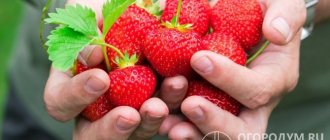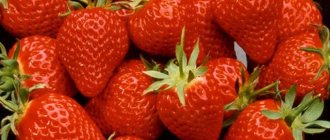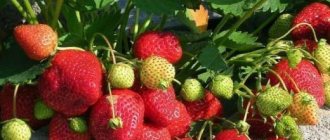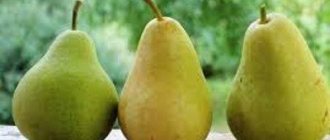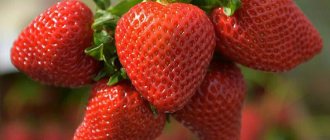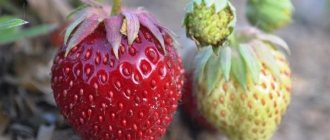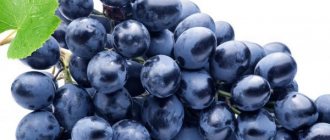Kupchikha is a hybrid variety obtained by crossing strawberries and wild strawberries. Zemklunik, taking the best qualities from each crop, has become a tempting object of cultivation for gardeners. Let's find out why it is interesting, how to plant and grow it.
variety of earthen grass "Kupchikha"
Earthweed "Kupchikha" is called a "fabulous" miracle berry
the “Kupchikha” variety has become popular not only with summer residents, but also with professional farmers
Origin of the Merchant's Wife
Breeders have long dreamed of crossing strawberries with wild strawberries. Soviet specialists achieved the greatest success in this. The Kupchikha variety was obtained in the 80s of the last century at the Bryansk Agrarian University. The variety was included in the State Register in 2021. This is the first and so far the only officially registered representative of zemclunica. The hybrid is recommended for cultivation in all regions of Russia.
When creating the hybrid, a parent pair was used - large-fruited garden strawberries and European muscat strawberries. The variety probably got its name from the elegance of the bushes. The flowering plant looks very beautiful - the foliage is thick, lush, and above it is a bouquet of large white flowers.
Description of the variety
Brief botanical description of the Kupchikha earthweed:
- Bush. Tall and strong, spherical in shape. Height - 20-30 cm. There are few whiskers, they are medium in size, with a red tint.
- Leaves. Round, concave. The surface is smooth and shiny. The edges are jagged. The leaf pubescence is slight, and the petioles are fluffy.
- Peduncles. Strong, thick, flowering abundantly. There are so many flowers that during their flowering period almost no leaves are visible. The flowers are large and snow-white. The middle is yellow.
- Fruit. Weight and size depend on the time of ripening. Shape – elongated, flattened. The berries look unusual - they bifurcate at the ends. Color – dark red, with a purple tint.
Characteristics
The concept of “earth strawberries” appeared in the 70s of the last century, when garden strawberries were first crossed with strawberries. Gardeners assure that this hybrid, unlike strawberries, never loses its specific strawberry aroma - even in the wettest and coldest summer.
Features of the Kupchikha dredge:
- They are grown in open ground and in greenhouses. In containers and pots.
- Suitable for amateur, small-scale and industrial cultivation.
- Combines the qualities of the parent pair: From strawberries, the hybrid gets a bright nutmeg aroma and dessert sweetness, the ability to adapt to different environmental conditions, endurance and high immunity.
- Strawberries give large fruits and high yield potential. Monoecious - the plant has bisexual flowers.
Table 1 shows the main agrotechnical parameters and characteristics of the Kupchikha dredge.
Table 1
| Parameters/characteristics | Meaning/Description |
| Ripening time | medium and mid-early variety |
| Productivity | 0.3-0.5 kg per bush or 1.35 kg per 1 sq. m |
| Form | asymmetrical |
| Taste | sweet, no sourness |
| Aroma | rich strawberry |
| Tasting score | 5 |
| Transportability | high |
| Resistance to diseases and pests | high |
| Drought resistance | average |
| Frost resistance | high (up to minus 24 °C) |
| Fruiting | non-repairable |
| Purpose | universal |
The ripening time of berries depends on the region and specific weather. In the middle zone, the first berries usually appear in early July. They are the largest - reaching 6 cm in length. The following berries are smaller - 3 cm in length.
Productivity of earthen grass Kupchikha
This variety is recommended for cultivation in greenhouses and open ground throughout Russia. Strawberry Kupchikha is not remontant
, so the bushes are harvested only once a season.
Due to the large size of the fruits, Kupchikha collects up to half a kilo of delicious, sweet, aromatic berries from each berry plant. And from a square you can collect up to one and a half kilograms.
In the middle zone, the first berries usually ripen in the first ten days of July, and their sizes are the largest (up to 6 cm in length). And the next harvested fruits are already smaller - up to 3 cm in length.
Advantages and disadvantages
Zemklunika, having inherited the positive qualities of the mother varieties of wild strawberries and strawberries, became the bearer of the following advantages:
- high productivity;
- almost 100% self-fertility;
- undemanding to growing conditions and care;
- decorative – during flowering;
- high frost resistance allows you to do without shelter in winter;
- high immunity to the most common strawberry and strawberry misfortunes - fungal infection and gray rot;
- resistance to strawberry mite;
- good survival rate in any climate;
- the possibility of independent reproduction - thanks to the growing mustache;
- bright taste characteristics;
- large berries - they are not as large as Gigantella Maxim or Albion, but much larger than many other varieties;
- They tolerate transportation well - they have dense flesh, they do not wrinkle, do not leak, do not rot;
- The berry is well stored, especially in the right container and at low temperatures.
The Merchant's Wife has few disadvantages:
- Not enough mustache. For gardeners who actively propagate berry crops, the existing mustache is only enough to renew the plantings.
- Heterogeneous berries. There are large, medium and small fruits. The berries also differ in shape - you can come across some rather bizarre specimens, this negatively affects the presentation.
- It freezes during recurrent frosts - such cases have been noticed in the central regions.
- Due to the abundance of flower stalks, dense plantings are observed. It is necessary to separate fruiting plantings and queen cells.
- In the rainy summer, Kupchikha does not have time to ripen in the northern regions, in the Urals and even in the Moscow region.
- With extensive agricultural technology, it becomes smaller within 2-3 years, and the yield decreases.
Selection and purchase of seedlings
Strawberries are not yet widespread enough, so under its guise unscrupulous sellers offer ordinary varieties of garden strawberries. To buy original seedlings, it is recommended to contact the originator of the variety - FGBNU VSTISP. The institute has an extensive sales network in Moscow and the region, so you can order high-quality seedlings here without any problems.
If seedlings are not purchased from the originator, it is necessary to check the appearance of the seedlings with the standard. Please note that Kupchikha seedlings were not yet available for sale in the fall of 2021. Anyone who claims that he has been selling Kupchikha’s seedlings for “more than a year” is deceiving the buyer.
Signs by which high-quality seedlings of earthworms are selected:
- well-developed root system, without defects or damage;
- maximum number of leaves – 3 pieces;
- absence of broken leaves, rot and other defects;
- the heart is strong, elastic, green.
Seedlings are sold in individual pots or with bare roots. If you purchase the second option, the seedlings must be planted immediately - no later than the next day. Before planting, seedlings are stored with the roots immersed in water.
The history of the appearance of the hybrid "merchant's wife"
Zemklunik "Kupchikha" was obtained at the famous experimental site in the village of Kokino, Bryansk region. The authorship belongs to the famous breeder, Professor S.D. Aitzhanova, who has been working on breeding various varieties of garden strawberries for more than three decades.
The parent forms of the “merchant’s wife” are certain varieties of garden strawberries (Fragaria ananassa) and strawberries (Fragaria moschata). The main problem that breeders tried to solve was the breeding of large-fruited berries, since the strawberry-strawberry hybrids of the first generations were small-fruited and had low berry set.
Numerous photos and reviews from gardeners show that the result was excellent. The new hybrid was given the name "merchant's wife". Based on strawberries and their characteristics, an application for admission was submitted in 2014, and in 2021 the hybrid was included in the list of the State Register of the Russian Federation (see video).
On a note! Of the numerous varieties of earthen grass bred by breeders, only this one is registered in the State Register for 2019.
Along with the “Kroshka” and “Anastasia” varieties, “Kupchikha”, which has no analogues in the world, is the pride of the Kokinsky breeding stronghold.
Site selection
The site for dredging can be located both in the sun and in partial shade. The berry can grow next to spreading fruit trees. The fruits, staying part of the day in the shade, ripen longer, but grow larger.
More features of the site for planting dredges:
- the site should be located in a well-ventilated place;
- Planting in lowlands where rain or melt water stands for a long time is not allowed;
- it is forbidden to plant after nightshades - there is a risk of infection with late blight;
- an unfavorable neighbor is raspberries; they have similar diseases and pests to strawberries.
Landing nuances
Adaptation of strawberries in a new place depends on proper planting.
Selecting a location
As a rule, sunny areas are chosen for strawberry bushes. Merchant's Wife grows well in partial shade. Berries are often planted next to fruit trees. With their branches they protect the bushes from scorching rays.
In partial shade, the ripening of strawberries is extended, but they are much larger in size. Planting in beds with poor ventilation is contraindicated. Unsuitable conditions for bushes are soil that does not dry out for a long time after precipitation.
Planting dates, preparation of soil and seedlings
If the dredge forms tendrils in its own area, they are planted in a new place from spring until autumn. The main condition is that they must take root before the start of winter cold. Before planting, the sprouts that were purchased in the spring are kept in a cool and well-lit place until the temperature outside stabilizes.
Planting is done in nutritious soil, which is carefully prepared. The beds are fertilized with humus if it is not possible to use a mixture of charcoal, superphosphate and ammonium nitrate.
The bushes are treated with root formation stimulants. To do this, use “Epin” or “Kornevin”.
Landing scheme and rules
Planting takes place in early spring or autumn. Maintain a distance between young plants of at least 30 cm. For row spacing, 50 cm is allowed. The optimal option is staggered planting.
Andalusian horse: grace and obedience of the Spanish stallion
This variety of strawberry grows quickly, so it will need a lot of space.
Soil preparation and fertilization
Earthweed is demanding on soil composition. The culture prefers light fertile soils, loams and sandstones with weak acidity. Before planting, the soil is enriched with organic and mineral fertilizers.
The amount of fertilizer applied depends on the fertility of the soil - the poorer it is, the more fertilizing it requires. Before digging up the beds, fertilizers are scattered over them (per 1 sq. m):
- humus or compost - 1-2 buckets;
- ammonium nitrate – 20-30 g;
- superphosphate – 20-40 g;
- wood ash - 2-3 cups.
It is also recommended to water the area with a solution of potassium permanganate (1 g per bucket) or copper sulfate (100 g per bucket) to disinfect the soil.
Features of agricultural technology
The yield indicators indicated in the description are achieved only with proper care of the crop. The species is unpretentious and winter-hardy, but this does not mean that the plants can be left without attention and care. The more careful the care, the higher the sweet harvest.
Selection and preparation of a site
Earthweed is grown on ridges of open ground. Many people are interested in where to plant this amazing crop. The variety is demanding on soil fertility, grows better and produces high yields in well-lit areas. Light partial shade is allowed, but you must be prepared for the fact that fruiting will begin later. The best soils are light loams, pH 6.5-7 (neutral).
On a note! On acidic soils, dolomite flour and chalk are added 1-2 years before planting the crop.
In low-lying areas and with close groundwater passage, high-quality drainage is installed. The ridges are dug up in the fall (when planting seedlings in the spring) or in the summer (if the dredge is planned to be placed in a permanent place in September or October).
Add compost, humus or well-rotted mullein (5-6 kg), wood ash (0.5 l), superphosphate (20 grams each). The standards are given for an area of 1 square meter. These fertilizers can be replaced with complex mineral fertilizers (nitroammophos, nitrophos).
Landing
Step-by-step recommendations for planting
Before planting, prepare the seedlings. Leave seedlings with exposed roots in water for 2-3 hours, and water those with closed roots. For better rooting and development, it is recommended to treat the roots with growth stimulants.
The best planting scheme for the Merchant's Wife is 50x50 cm. In the early years, until the bushes have grown, the beds will seem half empty. You can compact the plantings by adding them to a favorable neighborhood - plant onions, garlic, dill, parsley, lettuce, radishes, calendula, and low marigolds between the rows.
Step-by-step instructions for planting dredges:
- Make holes in the garden bed that correspond to the size of the roots - they should fit comfortably in the recess without creasing or curling up.
- Place the seedling in the hole, straightening the roots. Simply transfer the seedlings in cups along with a lump of earth.
- Cover the roots with soil, leaving all the petioles with leaves and the heart (bud in the center of the bush) above it. Press down the soil with your hands.
- Use a scoop to make a furrow 3-5 cm deep and water it. This method will prevent the heart from being flooded with water.
- Rake the furrow for watering. Sprinkle the soil in the garden bed with mulch - sawdust, hay, dried grass.
Dredgeweed is planted twice a season - in early spring and early autumn.
Care and cultivation
A merchant's wife is not raised in one place for a long time. Over time, a lot of bacteria and pests accumulate in the soil, because of this the bushes begin to wither and the yield drops. But for 3-4 years, Kupchikha bears fruit generously - if you provide it with watering, fertilizing, protection from frost, diseases and pests.
Watering: volumes and regularity
The merchant's wife can withstand the heat, but does not like drought. The optimal soil condition is constant moisture. It is allowed to water the plantings on the leaves, but not in sunny weather, and not during the ripening of the berries. When the berries are just filling and ripening, water is poured at the root so as not to provoke the appearance of gray rot.
Water consumption for one dredge bush is 1-2 liters. Water as needed - as soon as the soil dries out. When rainy weather begins - at the end of summer and autumn, the plantings are not watered. If there is no rain in the fall, then before winter they do one moisture-recharging irrigation, during which they pour out one and a half times more water than with regular irrigation. For such a moisture-loving crop as earthen grass, the optimal irrigation method is a drip system.
Feeding
If the dredge bushes look perfect - tall, densely leafy with large dark green leaves, then 4-5 feedings per season are enough.
Table 2 shows the timing of fertilizing and its composition.
table 2
| Fertilizer application timing | Method of application | Composition, doses per 10 liters of water |
| After the soil thaws | at the root | 50 g urea or 1-2 tbsp. l. ammonia, or complex fertilizers for wild strawberries (BioHumus, Fertik, etc.) |
| During flowering | spraying | 20 g boric acid |
| Appearance of the first ovaries | at the root | 50 g of nitroammofoska, or repeat fertilizing with complex fertilizer |
| After harvest | at the root | similar to the previous feeding |
| At the beginning of August - when the formation of new buds begins | spraying | 50 g urea |
All fertilizers used can be used for spraying - they will not harm the leaves. If the plants do not look good - the bushes do not grow well, the leaves are small, and the petioles are too thin, then the plantings are fed every two weeks - until the plants acquire a healthy appearance.
Shelter for the winter
The need to cover plantings for the winter depends on the growing region. Kupchikha's winter hardiness is average, so in snowless and frosty winters there is a possibility of bushes dying. If in the area where strawberries are grown, snow falls before frosts below 20 °C occur, insulation is necessary.
The spruce branches, as well as branches - birch, maple, bird cherry, etc., will protect the earthen plantings well from frost. The stems of raspberries, dill, and shrubs are also suitable. Gardeners often use agrofibre to cover plantings, having previously folded it in several layers.
The covering material must allow air to pass through and not rot in the beds. When spring comes, the shelter is removed, the soil is loosened and sprinkled with fresh mulch (read more about mulching the soil here).
What diseases may concern you?
The copyright holder Kupchikha claims that the hybrid is universally resistant to infections. In practice, this only means that this hybrid gets sick less often than other varieties. Table 3 shows the most common diseases of the Merchant and ways to combat them.
Table 3
| Diseases | Symptoms | How to fight? |
| Gray rot | Gray fluffy coating on the berries. The pulp under the spots of rot is brown and watery. | In the spring, when the snow melts, before flowering, after flowering and after harvesting - spray with Fitosporin (2 tbsp per bucket). Or a bright pink solution of potassium permanganate, or whey (per bucket - 1 liter), or brilliant green / iodine (per 10 liters - 40 drops). When symptoms of rot or spotting appear, spray with copper-containing fungicides, for example, HOM (per bucket - 40 g), copper sulfate (per bucket - 50 g), Bordeaux mixture 1%, Skor (per 10 l - 2 ml). 1 or 2 repeated sprays at intervals of weeks. |
| White spot | Round white spots bordered by red or purple circles appear on the leaves. | |
| Brown spot | On the leaves, between the veins, brown spots of different sizes and shapes appear. |
Prevention measures:
- weeding;
- timely harvesting;
- collection and destruction of affected berries;
- planting favorable crops between the beds - onions, garlic, etc.;
- 4 treatments with Bordeaux mixture, potassium permanganate solution, Fitosporin or other fungicide.
Pests and their control
Merchant's wife is resistant to pests, but under unfavorable conditions it can be affected by traditional berry pests. They not only destroy a significant part of the crop, but are also capable of weakening plants, even to the point of their death. Table 4 shows the main enemies of earthworms and methods of combating them.
Table 4
| Pests | Damage caused | How to fight? |
| Strawberry-raspberry weevil | Beetles with long proboscis feed on leaves. Eggs are laid in buds. The very first buds, a source of large berries, disappear. The larvae eat away the contents of the buds - they dry out and die. | When flower stalks begin to grow, as well as after picking berries, treat with insecticides, for example, Karbofos (per 10 l - 60 g), Aktara (per 10 l - 2 g), Inta-vir (per 10 l - 1 tablet). In autumn, at temperatures below +10 °C, the soil is loosened, destroying the wintering sites of weevils. |
| Strawberry mite | Small insects, invisible to the eye, destroy the bushes - they do not grow, young leaves do not open. The edges of the leaves curl inward, the color is yellowish. The berries become small and dry. In winter, plants freeze out. Up to 6 generations of ticks reproduce per season. | In spring, water the beds with water at a temperature of +60°C. In the spring or after harvesting, cover the beds with film for 2 days. The temperature under the film rises to 70°C, and the mites die. In this case, the leaves also die, but then new, healthy ones grow. From the moment the snow melts until flowering - treatment with acaricides. The interval between treatments is 10 days. Use Aktelik (2 ml per 2 liters of water), Fufanon (10 ml per bucket). The treatment is repeated after harvesting. |
Diseases and pests
The strawberry variety Kupchikha, according to gardeners, is resistant to diseases and pests, but problems cannot be completely avoided. Therefore, preventive measures are necessary.
Possible diseases and pests of the Kupchikha earthen grass:
- white and brown spotting;
- gray rot and late blight;
- strawberry mite;
- raspberry-strawberry weevil.
Preventive measures
- remove weeds in a timely manner, pick ripe berries;
- remove damaged leaves, bushes, berries;
- 4 times a year (early spring, before budding, after harvesting and before wintering) treat the plantings with 1% Bordeaux mixture;
- plant onions, garlic, marigolds and other fragrant plants between the Kupchikha bushes;
- treat plantings with fungicides against pests.
Strawberry propagation Kupchikha
Merchant's Wife is a hybrid, so it makes no sense to propagate it with seeds. Firstly, growing seedlings from seeds is labor-intensive, and seed germination is low. Secondly, seedlings grown from seeds do not retain their maternal characteristics.
The most reliable method of propagation of Kupchikha is vegetative. It allows you to quickly obtain new strawberries while preserving the varietal characteristics of the mother plant.
Mustache reproduction order:
- At the end of May, large, productive bushes are selected.
- The selected bushes are left with only a few tendrils and rosettes of the first order.
- Pin the selected mustache to the ground.
- All other tendrils are removed so that the plant directs its forces to rooting the rosettes.
- When the rosettes have 5 leaves, they are separated and transplanted to a previously prepared place.
Agrotechnical recommendations
For the full development of large dredge bushes, sparse planting is required with distances of 35-40 cm between plants. The bushes are able to actively bear fruit in one place for 5-6 years. After this, it is recommended to move the strawberry beds to another area. The hybrid is propagated by vegetative methods - young rosettes or dividing bushes. We invite you to watch a short video tutorial on this topic:
The bushes produce quite a sufficient number of mustaches for propagation by their own seedlings. It is recommended to remove excess tendrils and rosettes so that they do not thicken the plantation. Young seedlings take root easily and even when planted in the fall in the middle zone, they safely survive without shelter for the winter and produce a harvest the following season.
Growing "Kupchikha" does not require special agrotechnical efforts; it is enough to adhere to the standard requirements:
- prepare the soil by adding organic matter or mineral fertilizers before planting seedlings;
- fertilize before flowering, during fruiting and after harvesting;
- water at least once a week, especially during dry periods;
- weed and loosen or mulch the soil.
It is recommended to plant strawberry seedlings “Kupchikha” in one line or in a checkerboard pattern, leaving a distance of about 40 cm between the bushes
You can choose a place to place the dredges that is sunny or in partial shade (clearings under trees or shrubs). Bushes growing in areas with varying degrees of illumination do not bear fruit at the same time and allow the harvest period to be extended to 5-6 weeks. Decorative properties, unpretentiousness and excellent taste of fragrant berries have made the “Kupchikha” strawberry a popular home crop, which is successfully grown in large pots placed on a windowsill or balcony.
Harvesting, storage and transportability
Berry picking is gradual. The first berries ripen around the end of June. They can be stored, but not for long - it is better to recycle them as soon as possible. The Merchant's Wife has good transportability - it can be transported over short and long distances without losing its marketable qualities. Suitable for sale in markets and stores.
Kupchikha berries are very tasty fresh, especially with sugar and cream. They go harmoniously with ice cream and baked goods. The berries are processed - jams, jams, compotes are made, dried, liqueurs, liqueurs and tinctures are prepared.
Difficulties in growing and useful tips
Growing a Merchant's Wife will not create any particular difficulties if you follow agricultural techniques. If a crop does not produce the expected yield, is sick, or does not develop, it means that somewhere a mistake was made or something was missed. Table 5 shows problems in growing earthworms, their causes and recommendations for elimination.
Table 5
| Problem | Probable Causes | How to fix it? |
| Low yield | the area is poorly lit | transplant the earthworm to a more sunny place |
| Roots rot, growth slows | deep landing | replant bushes correctly |
| The plant does not take root well | the plant was planted incorrectly - more than three leaves were left on the bush; or planting error - the bushes are planted shallow | replant or wait - the plant can still grow |
| The bush grows poorly, the leaves are small, the petioles are thin | the soil is infertile | 2-3 times a month – fertilizing with complex fertilizers |
| Suffers from gray rot, brown or white spotting | waterlogged soil; watering on the leaves during the formation of ovaries and during the ripening period; or planting density | reduce the frequency of watering, divert water or transplant to a drier place, if thickening - plant strawberries |
| Sick of late blight | the rules of crop rotation were violated - the strawberries were planted after the nightshades | transplant to a new place |
When planting seedlings propagated by mustaches, powerful and large bushes are obtained. The survival rate of such seedlings is almost 100%.
How to increase productivity?
Considering the small number of tendrils, the Kupchikha variety of dredges is quite easy to care for; you don’t need to spend a lot of time tearing them off, and yet, in order to increase the yield, the tendrils must be constantly removed from bushes that are left only for harvesting. If they are not removed, they will only draw juices from the plant.
The yield is also affected by how close the bushes are to each other. They need to be planted at a considerable distance, otherwise they simply will have nothing to “breathe” and “eat”, since the earth will quickly become impoverished.
And finally, fertilizers - every spring it is worth fertilizing the beds with a mixture of humus or compost with ash in order to restore the balance of nutrients in the soil, because this is the main nutrition of the future harvest.
Reviews about the hybrid
★★★★★
Ilya N., Saratov region. The main thing that makes this berry memorable is its unusual shape and excellent taste.
The berries are strangely shaped, with ears, and the taste is sweet, strawberry. The pulp is dense, not watery, and can be transported and stored for 1-2 days without any problems. A noticeable drawback is that it is affected by gray rot. Advice - it is better to plant the Merchant's Wife in the shade. Here it turns out larger and sweeter. ★★★★★
Maria I., Bryansk region. Kupchikha has excellent pollination ability, she practically does not get sick, does not freeze, and is not afraid of ticks.
Tolerates rainy weather well. There is no need to spray with chemicals - the berries are environmentally friendly. There are up to 30 flower stalks on one bush - very high yield. If you dry the berries and then grind them in a coffee grinder, you get an amazing seasoning for tea and baking. Hide
Add your review
The fruitful Kupchikha, with its surprisingly tasty berries, appealed to both amateur gardeners and farmers involved in commercial berry growing. The main problem is to find original seedlings. Strawberries are not very common, and sellers often substitute ordinary garden strawberries instead of strawberries.
0
0
Copy link
Reviews
According to my taste, the clear leader is the Merchant's Wife. Very pleasant nutmeg aroma and sweet taste. Frozen berries and jam turn out amazing. I also dry part of the harvest and in the winter I treat my grandchildren to berry chips, it’s delicious, you won’t be able to pull it off by the ears.
“Kupchikha” responds well to feeding with ash or mineral fertilizers - potassium monophosphate. The berries become larger and the taste is more aromatic. I think that everything is fine in “Kupchikha”. I can only note 2 drawbacks: a very large number of whiskers (need to be constantly removed) and the white tips of the berries. If you wait for full ripening, the base will already become withered.
Not my taste. I prefer the standard strawberry scents, with Asia and Syria being my favorites. And ants really love this variety; you have to look at every berry from all sides, otherwise you’ll eat insects.
The rules of Kupchikha's agricultural technology are even simpler than those of traditional strawberry varieties. Particular attention should be paid to the variety by eternally busy city summer residents who only have short weekends to communicate with nature.
Strawberries of the Kupchikha variety will not only provide the gardener with delicious berries. The strawberry bushes that bloom at the end of May are unusually decorative and can become a real decoration of the garden.

